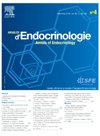催乳素瘤患者高催乳素血症、代谢紊乱和心血管风险的关系
IF 2.9
3区 医学
Q3 ENDOCRINOLOGY & METABOLISM
引用次数: 0
摘要
催乳素瘤是最常见的垂体腺瘤类型,然而多巴胺负反馈的抑制,以及中枢神经系统脂肪生成和多巴胺能紧张,是导致体重增加和代谢异常的机制。目的了解垂体腺瘤继发高泌乳素血症患者代谢紊乱的发生率,并评估其心血管风险。材料与方法回顾性研究时间为3年。代谢综合征的诊断仍符合IDF 2023标准。根据Framingham评分估计的心血管风险水平,糖尿病患者为2分。采用SPSS 26软件进行统计学分析。我们将患者分为A组:阳性代谢综合征患者和B组:阴性代谢综合征患者。结果共纳入80例患者。平均年龄38.17±14.61岁,性别比2.06。平均BMI为25.34±9.94 kg/m2。平均腰围为75.98±10.7 kg/cm2。肥胖、高血压、糖尿病、高甘油三酯血症和低血糖血症的患病率分别为34、18、11、61、79%。A组平均催乳素水平为765.6 ng/mL,平均心血管风险为15.8±4.25%。B组:平均催乳素水平325.8 ng/mL,平均心血管风险7.23±3.8%。多变量分析显示,平均催乳素(P <;0.001)、代谢紊乱(P = 0.029)和心血管风险(P = 0.019)。结论代谢综合征及其参数是心血管风险增加的原因,因此我们的研究表明,使用多巴胺能激动剂治疗可以改善其参数。本文章由计算机程序翻译,如有差异,请以英文原文为准。
Relationship between hyperprolactinemia, metabolic disorders and cardiovascular risk in patients with prolactinoma
Introduction
Prolactinomas are the most common type of pituitary adenoma, however suppression of negative dopamine feedback, as well as CNS lipogenesis and dopaminergic tone, are mechanisms responsible for weight gain and metabolic abnormalities.
Objective
To determine the prevalence of metabolic disorders and assess cardiovascular risk in patients with hyperprolactinemia secondary to pituitary adenoma.
Materials and methods
Retrospective study spread over 3 years. The diagnosis of metabolic syndrome retained according to IDF 2023 criteria. The level of cardiovascular risk estimated by the Framingham score and score 2 for diabetics. Statistical analysis was performed using SPSS 26 software. Our patients were classified into group A: patients with positive metabolic syndrome and group B with negative metabolic syndrome.
Results
In all, 80 patients were included. Mean age was 38.17 ± 14.61 years and sex ratio was 2.06. Mean BMI was 25.34 ± 9.94 kg/m2. Mean waist circumference was 75.98 ± 10.7 kg/cm2. Prevalences of obesity, hypertension, diabetes, hypertriglyceridemia and hypoHDLemia were 34, 18, 11, 61, 79% respectively.
In group A: mean prolactin level was 765.6 ng/mL, mean cardiovascular risk was 15.8 ± 4.25%. Group B: mean prolactin level 325.8 ng/mL, mean cardiovascular risk 7.23 ± 3.8%.
Multivariate analysis revealed a significant association between mean prolactin (P < 0.001), metabolic disorders (P = 0.029) and cardiovascular risk (P = 0.019).
Conclusion
The metabolic syndrome and its parameters are responsible for an increase in cardiovascular risk, hence the interest of treatment with dopaminergic agonists to improve its parameters, as illustrated in our study.
求助全文
通过发布文献求助,成功后即可免费获取论文全文。
去求助
来源期刊

Annales d'endocrinologie
医学-内分泌学与代谢
CiteScore
4.40
自引率
6.50%
发文量
311
审稿时长
50 days
期刊介绍:
The Annales d''Endocrinologie, mouthpiece of the French Society of Endocrinology (SFE), publishes reviews, articles and case reports coming from clinical, therapeutic and fundamental research in endocrinology and metabolic diseases. Every year, it carries a position paper by a work-group of French-language endocrinologists, on an endocrine pathology chosen by the Society''s Scientific Committee. The journal is also the organ of the Society''s annual Congress, publishing a summary of the symposia, presentations and posters. "Les Must de l''Endocrinologie" is a special booklet brought out for the Congress, with summary articles that are always very well received. And finally, we publish the high-level instructional courses delivered during the Henri-Pierre Klotz International Endocrinology Days. The Annales is a window on the world, keeping alert clinicians up to date on what is going on in diagnosis and treatment in all the areas of our specialty.
 求助内容:
求助内容: 应助结果提醒方式:
应助结果提醒方式:


